Thomas P. Barnett
Thomas P. Barnett (February 11, 1870 – September 23, 1929), also known professionally as Tom Barnett and Tom P. Barnett, was an American architect and painter from St. Louis, Missouri. Barnett was nationally recognized for both his work in architecture and in painting.[1]
Thomas P. Barnett | |
|---|---|
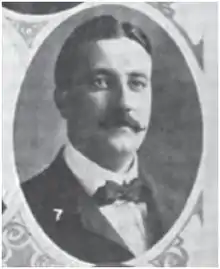 Tom P. Barnett in 1904 | |
| Born | February 11, 1870 |
| Died | September 23, 1929 (aged 59) |
| Nationality | American |
| Known for | Architecture & Painting |
| Notable work | Buildings: Cathedral Basilica of St. Louis, Adolphus Hotel, Busch Mausoleum Paintings: Close of a Winter Day, Forest Park Landscape, Riches of the Mines |
Architectural work
Barnett trained under his father, St. Louis architect George I. Barnett, who was known for designing public landmarks such as the renovation of the Old Courthouse, the Missouri Governor's Mansion, and the structures of the Missouri Botanical Garden.[2] In painting, the younger Barnett trained at the St. Louis School of Fine Arts , with a fair list of awards and exhibitions.[3]
After graduating Saint Louis University in 1886, Tom Barnett joined with his brother and brother-in-law, George Dennis Barnett and John Ignatius Haynes, to form the architectural firm Barnett, Haynes & Barnett.[1] The firm continued the traditional motifs of the elder George Barnett. The combined legacy of two generations of Barnett designs were largely responsible for Classicism being the dominant architectural influence in St. Louis.[4]
In 1904, Barnett served on the Commission of Architects for the Louisiana Purchase Exposition (better known as the St. Louis World's Fair) and personally designed the Palace of Liberal Arts for which he earned the fair's Gold Medal for Architecture.[5] The following year, he would win the Bronze Medal for Architecture at the Lewis and Clark Centennial Exposition in Portland, Oregon.[6]
Other projects designed by Barnett included commercial buildings, residential (including private places), and a significant number of religious structures. Surviving examples include the Cathedral Basilica of St. Louis, the Adolphus Hotel in Dallas, Texas, and the Saint Clement Catholic Church in Chicago.[7]
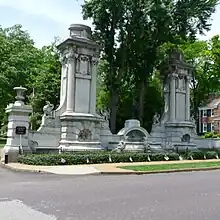 Kingsbury Place in St. Louis, 1902
Kingsbury Place in St. Louis, 1902 Palace of Liberal Arts at the 1904 World's Fair
Palace of Liberal Arts at the 1904 World's Fair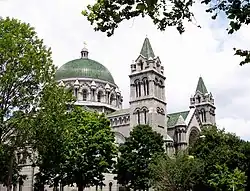
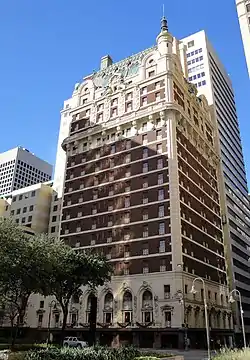 Adolphus Hotel in Dallas, 1912
Adolphus Hotel in Dallas, 1912 Cathedral of St. Patrick in El Paso, 1914
Cathedral of St. Patrick in El Paso, 1914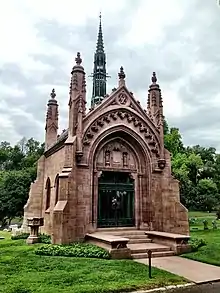 Busch Mausoleum in Bellefontaine Cemetery, 1915
Busch Mausoleum in Bellefontaine Cemetery, 1915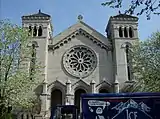 Saint Clement Catholic Church in Chicago, 1917
Saint Clement Catholic Church in Chicago, 1917
Painting
Later in life, Barnett turned his attentions primarily to painting. He studied under Paul Cornoyer, and followed the American Impressionism style.[5] Barnett characteristically used wide brush strokes and vibrant colors. His works typically idealized his subjects, and were emotionally expressive and optimistic.[8]
Barnett's paintings were well received in his lifetime. His works were exhibited at the Panama–Pacific International Exposition,[9] the first exhibition of the Society of Independent Artists in New York,[10] the Cincinnati Art Museum,[11] the Art Institute of Chicago,[12] the Pennsylvania Academy of the Fine Arts,[13] and with regularity at the Saint Louis Art Museum.[14] Barnett won both local and national awards including the Bronze Medal for Painting at the Lewis and Clark Centennial Exposition in 1905, and the First Ives Landscape Prize from the St. Louis Artist's Guild every year between 1914 and 1925.[6]
In 1922, Barnett painted the 12' by 6' mural, Riches of the Mines, in the Missouri State Capitol in Jefferson City. The lunette representing a zinc mine in southwest Missouri was a favorite of art critics who marveled at Barnett's ability to depict drama and beauty in an otherwise bleak and desolate scene.[15]
Barnett was a member of the Chicago Art Guild, National Arts Club, St. Louis Artist's Guild, Salmagundi Club, Chicago Galleries Association, Allied Artists of America, and the American Federation of Arts.[6]
Works by Barnett are held in the permanent collections of the Art Institute of Chicago, the Detroit Institute of Arts, the Saint Louis Art Museum, the art collection of the Missouri State Capitol, the Missouri History Museum, the Museum of Art and Archaeology at the University of Missouri, and the Busch family collection housed at Grant's Farm.[6]
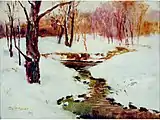 Winter River Landscape, 1907
Winter River Landscape, 1907 Close of a Winter Day, 1914, in the collection of the Saint Louis Art Museum
Close of a Winter Day, 1914, in the collection of the Saint Louis Art Museum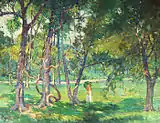 Forest Park Landscape, 1916
Forest Park Landscape, 1916 Riches of the Mines, 1922, mural in the Missouri State Capitol
Riches of the Mines, 1922, mural in the Missouri State Capitol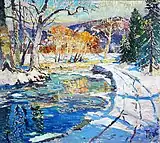 In the Heart of the Ozarks, 1925
In the Heart of the Ozarks, 1925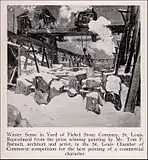 Pickle Stone Company, 1925
Pickle Stone Company, 1925 Construction of the River des Peres Channel in Forest Park, 1927
Construction of the River des Peres Channel in Forest Park, 1927 Mid Winter, 1929
Mid Winter, 1929
References
- Leonard, John W. The Book of St. Louisans. The St. Louis Republic, 1906, p. 38.
- Sharoff, Robert. American City, St. Louis Architecture, Three Centuries of Classic Design. The Images Publishing Group, 2010, p. xi.
- Special Exhibition Catalog. City Art Museum of St. Louis. 1 January 1914. p. 25. Retrieved 28 June 2021.
- Sharoff, Robert. American City, St. Louis Architecture, Three Centuries of Classic Design. The Images Publishing Group, 2010, p. xi.
- Levy, Florence N. American Art Annual. American Art Annual Inc, 1903, p. 246.
- Thomas P. Barnett at archINFORM. Retrieved 6 January 2013.
- "Barnett, Haynes & Barnett | Companies". Emporis. Archived from the original on June 29, 2011. Retrieved 2013-01-06.
- Rea, Andrew. "Art reveals winter's varying shades", Columbia Missourian, December 18, 2008
- Official Catalogue of the Panama-Pacific Exhibition. San Francisco, California, 1915
- Catalogue of the First Annual Exhibit of the Society of Independent Artists. New York, 1917
- Annual Exhibition of the Society of Western Artists catalogue. Cincinnati Art Museum, 1902
- Catalogue of the 11th Annual Exhibition of Oil Paintings & Scultptures of American Artists. Art Institute of Chicago, 1898
- Catalogue of the 114th Annual Exhibition. Pennsylvania Academy of the Fine Arts, 1919
- Catalogue of the City Art Museum of St. Louis. every year 1913-1929.
- Priddy, Bob & Jeffrey Ball. The Art of the Missouri Capitol; History in Canvas, Bronze, and Stone. University of Missouri Press, 2011, p. 194.